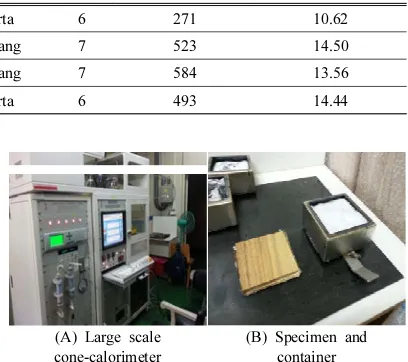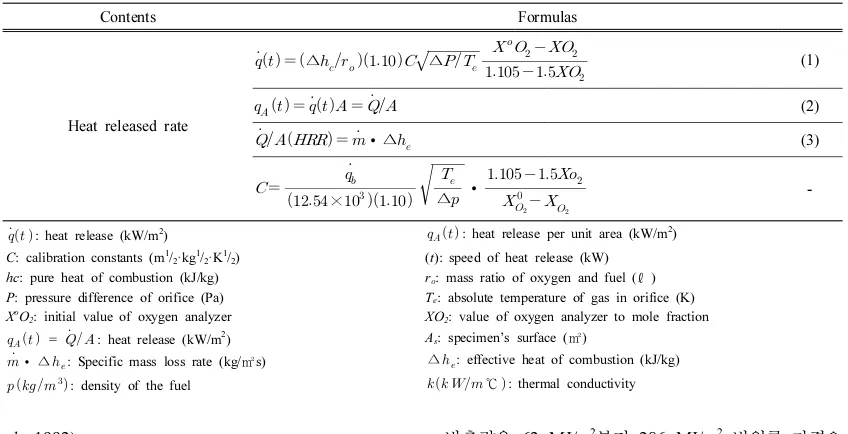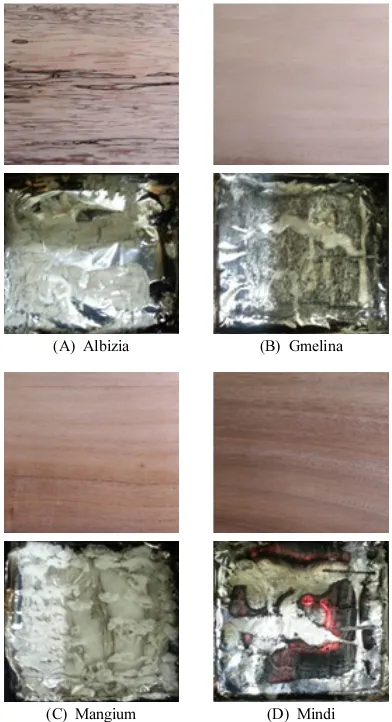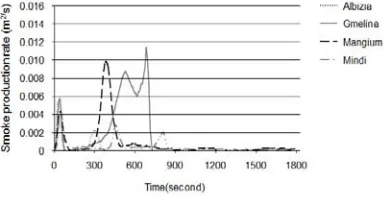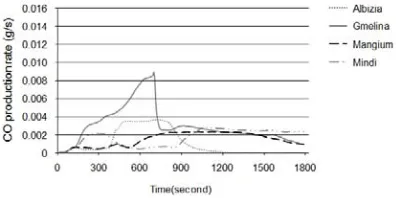1Date Received July 6, 2015, Date Accepted August 19, 2015
2강원대학교 산림환경과학대학. College of Forest & Environmental Sciences, Kangwon National University, Chuncheon 24341, Republic of Korea
3Faculty of Forestry, Bogor Agricultural University, Bogor 16680, Indonesia †교신저자
(Corresponding author): 김남훈(e-mail: kimnh@kangwon.ac.kr)
인도네시아 주요 조림수종의 연소특성
1박 세 휘
2⋅
장 재 혁
2⋅
Wahyu Hidayat
2⋅
Yue Qi
2⋅
Fauzi Febrianto
3⋅
김 남 훈
2,†Combustion Properties of Major Wood Species Planted in Indonesia
1Se-Hwi Park
2⋅
Jae-Hyuk Jang
2⋅
Wahyu Hidayat
2⋅
Yue Qi
2⋅
Fauzi Febrianto
3⋅
Nam-Hun Kim
2,†요 약
본 연구에서는 인도네시아 조림지에서 생장한 4수종의 효율적 활용방안을 마련하기 위해 콘칼로리미터법에 의해 연 소특성을 조사하였다. 그 결과, 평균열방출량(HRRmean)은 비중에 비례하였으며, 총열방출량(THR) 및 연소시간(FT) 등 열관련 계수도 같은 경향을 나타냈다.
Albizia는 열방출 시간이 짧았고, Mindi는 4수종 중 점화시간(TTI)과 연소시간(FT)이 길어져 4수종 중 연소속도가 늦었고, 열방출 시간도 가장 길게 이어져 결국은 Mangium 수종과 비슷한 총열방출률을 나타내는 것을 확인할 수 있었 다. Albizia는 공시수종 중 가장 높은 비소화면적 값을 나타내어 연기발생비율이 높았고, 반대로 Mindi는 가장 낮은 비 소화면적 값을 나타내 연기발생비율이 낮았다. 초기 연기방출률은 Albizia가 높았으나 이후에는 Gmelina와 Mangium
의 연기방출률이 높아져 총연기발생량이 높게 나타났다. Gmelina는 불완전연소로 인해 연소기간 중 가장 많은 일산화 탄소 연기를 생성하였고, CO/CO2 비율은 다른 수종에 비해 3배 이상 높았다.
ABSTRACT
1. 서 론
(Paraserianthes falcataria), Gmelina (Gmelina
arbor-ea), Mangium (Acacia mangium) 및 Mindi (Melia
monoxide during the combustion period and presented three times higher CO/CO2ratio than those of other species due
to incomplete combustion.
바지역의 Purwakarta와 Bogor에 위치한 대한민국 산
림조합중앙회의 조림지역에서 채취되었다. Albizia
(Paraserianthes falcataria)와 Mindi (Melia
azedar-ach)는 2010년 Purwakarta지역에 조림된 수종이고
Gmelina (Gmelina arborea)와 Mangium (Acacia
mangium)은 2009년 Bogor지역에 조림된 수종이다. 중요한 요소이다(Barbrauskas, 1984; Barbrauskas et
Common name Scientific name Location Age Density (kg/㎥) Moisture contents (%)
Albizia Paraserianthes falcataria Purwakarta 6 271 10.62
Gmelina Gmelina arborea Parunpanjang 7 523 14.50
Mangium Acacia mangium Parunpanjang 7 584 13.56
Mindi Melia azedarach Purwakarta 6 493 14.44
Table 1. Materials for combustion test
(A) Large scale cone-calorimeter
(B) Specimen and container
al., 1992). P: pressure difference of orifice (Pa) Te: absolute temperature of gas in orifice (K)
XoO
2: initial value of oxygen analyzer XO2: value of oxygen analyzer to mole fraction = : heat release (kW/m2) As: specimen’s surface (㎡)
∙∆: Specific mass loss rate (kg/㎡s) ∆: effective heat of combustion (kJ/kg) : density of the fuel
에 도달하여 본 연구의 결과와 일치하는 것을 확인
하였다. Mindi 는 Table 3과 Fig. 2에서 보여주는 것
과 같이 점화시간(TTI)과 연소시간(FT)이 길어져 4
수종 중 연소속도가 늦었고, 열방출 시간도 가장 길
게 이어져 결국은 Mangium 수종과 비슷한 총열방출 을 나타내는 것을 확인할 수 있었다.
Fig. 3은 공시수종 목재의 연소과정 전후의 형태를
비교한 사진이다. 다른 세 수종은 소량의 회백색의 재만 남은 것이 관찰된 것에 비해, Mindi는 불완전
연소에 의해 검은색의 잔여물이 많이 남은 것을 관
찰할 수 있었다. 이를 통해 Mindi 수종은 다른 수종
에 비해 연소특성이 다소 다른 것으로 판단되었다.
Tran et al. (1992)의 연구에서 연소특성은 비중에
비례하는 것으로 보고하였다. 재료의 연소로 인한 열
방출률과 단위면적당 열방출량은 Table 2의 식(1)과
(2)에 의하여 계산되며, 식(3)에서 열방출률(HRR)은 비질량손실률(SMLR)과 유효연소열(EHC)의 곱이며,
항목 단위 Albizia Gmelina Mangium Mindi
aSMLR
ave (g/s⋅㎡) 1.69 3.09 2.86 3.82
bHRR
mean (kW/㎡) 23.67 25.87 40.13 41.77
cHRR
peak (kW/㎡) 105.54 78.07 145.61 100.82
dTHR (MJ/㎡) 44.3 48.0 75.1 76.7
eTTI (s) 12 29 19 48
fFT (s) 315 355 395 480
gEHC (MJ/kg) 14.71 19.72 22.93 25.63
a: Specific mass loss late, b: Mean heat release rate, c: Peak heat release rate, d: Total heat release, e: Time to ignition, f: Flaming time, g: Effective heat of combustion.
Table 3. Thermal properties of each species
Fig. 2. HRR curves of each wood species at 50 kW/m2 radiant heat flux.
(A) Albizia (B) Gmelina
(C) Mangium (D) Mindi
열방출률은 비질량손실률(SMLR)에 비례한다는 점
항목 단위 Albizia Gmelina Mangium Mindi
aTOC (g) 31.4 38.4 57.4 58.8
bTSR (㎡/㎡) 996.8 1186.9 932.4 984.3
cSEA
mean (㎡/kg) 602.1 455.1 472.6 406.2
COmean (kg/kg) 1.02 2.94 1.45 1.63
CO2mean (kg/kg) 23.41 25.79 39.19 40.39
CO/CO2 CO/CO2 4.3 11.3 3.6 4.0
a: Total oxygen consumption, b: Total smoke release, c: Specific extinction area Table 4. Smoke properties of each species
는 약 1200초에서 연소가 종료되어 CO2 발생률이
Gmelina (2.94 kg/kg), Mangium (1.45 kg/kg) 및
Mindi (1.63 kg/kg)로서 Albizia가 가장 적고
Fig. 5. CO2 production rate curves of each wood
species at 50 kW/m2 radiant heat flux.
본 연구의 결과를 통해 열대조림목의 향후 국내
Audeber M., Dhima D., Taazount M., Bouchair, A.
2013. Thermo-mechanical behaviour of
tim-ber-to-tiber conections exposed to fire. Fire
Safety Journal 56: 52-64.
Babrauskas, V. 1984. Development of cone
calo-rimeter: A bench-scale consumption. Fire and
Materials 8(2): 81-95.
Babrauskas, V., Grayson, S.J. 1992. Heat release in
fires. E&FN Spon (Chapman and Hall), London,
UK.
Baysal, E., Altinok, M., Colak, M., Ozaki, S.K.,
Toker, H. 2007. Fire Resistance of Douglas fir
(Psedotuga menzieesi) treated with borates and
natural extractives. Bioresources Technology 98:
1101-1105.
Brostow W., Menard K., Menard, N. 2009.
Combustion properties of several species of
wood. Chemistry & Chemical Technology 3(3):
173-176.
Choi, J.M. 2011. A study on combustion
character-istics of fire retardant treated Pinus densiflora
and Pinus koraiensis. Journal of the Korean
Wood Science and Technology 39(3): 244-251.
Chun, Y.J., Jin, E. 2010. Combustion characteristics
of the Pinus rigida and Castanea savita dried at
room temperature. Journal of Korean Institute of
Fire Science and Engineering 24(3): 86-92.
Drysdale D. 1996. An introduction to fire dynamics.
john Wily & Sons, USA.
Hull R.T. and Paul K.T. 2007. Bench-scale
assess-ment of combustion toxicity - a critical analysis
of current protocols. Fire safety Journal 42(5):
340-365.
Jang, S.R., Jang, J.H., Kim, J.H., Febrianto, F., Kim,
N.H. 2014. Anatomical characteristics of major
plantation species growing in Indonesia Ⅱ.
Journal of the Korean Wood Science and
Technology 42(6): 635-645.
Kim, C.J., Masataka, A., Kang, K.K. 1999.
Combustion characteristics of wood chips
(Ⅱ)- Flame shape of combustion and ignition
delay. Journal of the Korean Society of
Industrial Application 2(2): 139-146.
Kim, J.H., Jang, J.H., Kwon, S.M., Febrianto, F.
Kim, N.H. 2012. Anatomical properties of major
planted and promising species growing in
Indonesia. Journal of the Korean Wood Science
and Technology 40(4): 244-256.
Kim, J.H., Jang, J.H., Ryu, J.Y., Febrianto, F.,
Hwang, W.J., Kim, N.H. 2014. Physical and
me-chanical properties of major plantation and
promising tree species grown in Indonesia(Ⅰ).
Journal of the Korean Wood Science and
Technology 42(4): 467-476.
Korean Agency for Technology and Standard. 2006.
Reaction to fire test-Heat release, smoke
pro-duction and mass loss late - Part 1 : Heat
re-lease rate(Cone calorimeter method). KS F ISO
5660-1.
Park S.B., Park, J.S. 2012. Combustion
character-istics of bamboo charcoal boards. Journal of the
Korean Wood Science and Technology 40(1):
19-25.
Pearce, F.M., Khanna, Y.P., Raucher, D. 1981.
Thermal analysis in polymer flammability.
Chapter 8: Thermal characterization of polymeric
Quintiere, J.G. 1992. A semi-quantitative model for
the burning rate of solid materials. NISTIR
4840, National institute of standards and
technol-ogy, Gaithersburg, MD.
Ragland. K.W. and Aerts D.J. 1991. Properties of
wood for combustion analysis. Bioresource
Technology 37: 161-168.
Shafizadeh, F., Degroot, W.F. 1976. Combustion
characteristics of cellulosic fuels in : Tillman,
thermal uses and properties of carbohydrates and
lignins. Academic press. New York, USA.
Son, D.W. and Kang, S.G. 2014. Combustion
Properties of Woods for Indoor Use (I).
Journal of the Korean Wood Science and
Technology 42(6): 675-681.
Son, D.W., Kang, M.R., Son, S.W., So, I.S., Park,
S.B. 2014. Comparison of combustion
character-istics of woods used in indoor. Proc. of 2014
Annual Meeting of The Korean Society of Wood
Science and Technology. Cheong-Ju, Republic of
Korea. pp. 348-349.
Tran, H.C., White, R.H. 1992. Burning rate of solid
wood measured in a heat release calorimeter.
